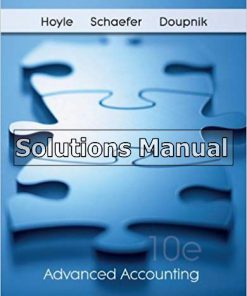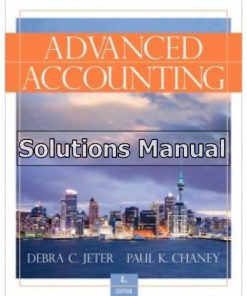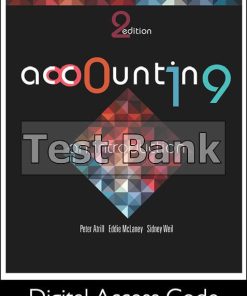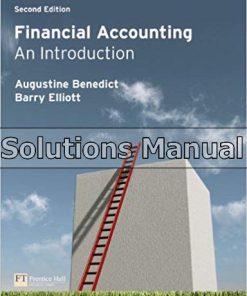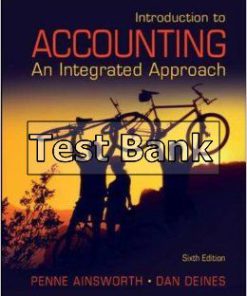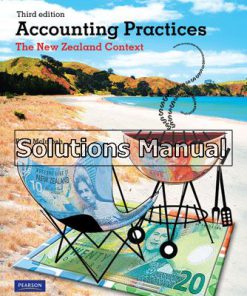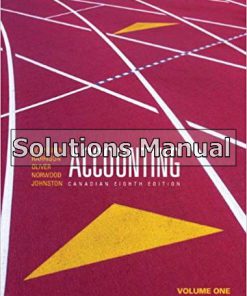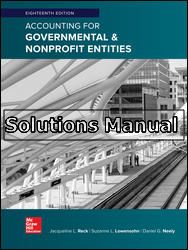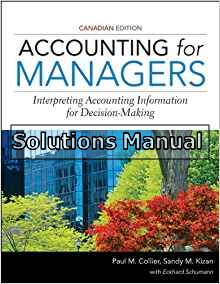- You cannot add another "Advanced Accounting 4th Edition Jeter Solutions Manual" to your cart. View cart
Accounting An Introduction 6th Edition Atrill Solutions Manual
You may also like
Accounting An Introduction 6th Edition Atrill Solutions Manual
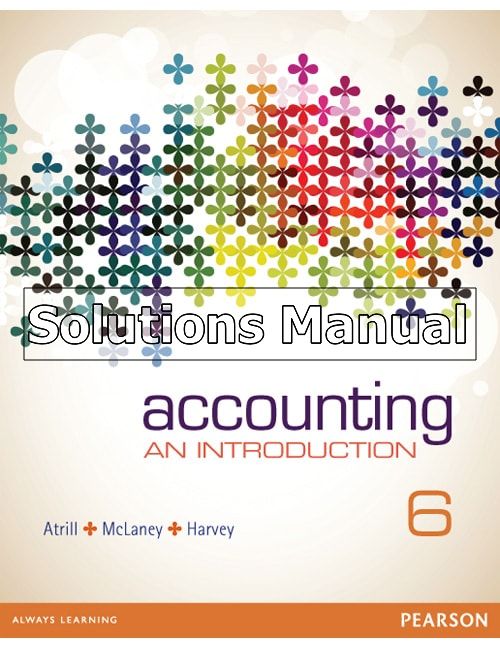
Product details:
- ISBN-10 : 0273771833
- ISBN-13 : 978-0273771838
- Author:
This successful text provides a comprehensive yet balanced introduction to financial accounting, management accounting and the basics of financial management. The text is specifically designed for non-specialist students, explaining the fundamental principles clearly and concisely, whilst showing how accounting information can be used to make decisions in a real business context.
Table contents:
- 1.1 Definition of accounting
- 1.2 First: A bit of history
- 1.2.1 The first accounting records
- 1.2.2 Who was responsible for the creation of the double entry system?
- 1.2.3 What is this book about?
- 1.3 Demystifying the jargon
- 1.4 The environment of accounting
- 1.4.1 The purpose of an economic system
- 1.4.2 Money as a unit of exchange
- 1.4.3 The financial system
- 1.5 Business organisations
- 1.5.1 Classification of business by activity
- 1.5.2 Setting up a business
- 1.5.3 Operating a business
- 1.6 The purpose of accounting
- 1.6.1 Why is it necessary to create a record of transactions in a business?
- 1.6.2 Who are the economic decision-makers, and what decisions do they need to make?
- 1.6.3 What information will assist people in making economic decisions?
- 1.6.4 How is financial information communicated?
- What have we learnt in this chapter?
- What’s next?
- 2 The purpose of accounting
- Learning objectives
- 2.1 Key financial decisions
- 2.1.1 Financing decisions
- 2.1.2 Investing decisions
- 2.1.3 Operating decisions
- 2.1.4 Distribution decisions
- 2.2 Understanding the statement of financial position
- 2.2.1 Understanding more about assets
- 2.2.2 Understanding more about liabilities
- 2.2.3 Understanding more about equity
- 2.3 Understanding profit or loss and comprehensive income
- 2.3.1 Income and expenses
- 2.3.2 Understanding accrual
- 2.3.3 Understanding profit
- 2.4 An introduction to statement of changes in equity
- 2.5 Understand the statement of cash flows
- What have we learnt in this chapter?
- What’s next?
- Questions
- 3 The practice of accounting
- Learning objectives
- 3.1 The accounting equation in more detail
- 3.2 The double entry principle
- 3.3 What are source documents?
- 3.3.1 Deposit slip
- 3.3.2 Loan application
- 3.3.3 Cheques
- 3.3.4 Internet banking
- 3.3.5 Cash receipt
- 3.3.6 Credit sales/credit purchases invoice
- 3.4 Journal entry
- 3.5 Recording information in the general ledger
- 3.5.1 What is the general ledger?
- 3.6 Extracting a trial balance
- 3.7 Closing entries
- 3.8 Reviewing the accounting cycle
- 3.8.1 Source documents
- 3.8.2 Journal entries
- 3.8.3 General ledger
- 3.8.4 Trial balance
- 3.8.5 Financial statements
- 3.9 How do specialised journals form part of the accounting cycle?
- 3.9.1 Cash Receipts journal
- 3.9.2 Cash Payments journal
- 3.9.3 Purchases journal
- 3.9.4 Sales journal
- 3.10 Pulling it all together
- What have we learnt in this chapter?
- What’s next?
- Questions
- 4 The conceptual framework
- Learning objectives
- 4.1 Generally accepted accounting practice
- 4.2 The objective of financial reporting
- 4.2.1 Who are the primary users of financial statements?
- 4.2.2 Who else would be interested in the financial statements?
- 4.2.2.1 Customers
- 4.2.2.2 South African Revenue Services (SARS)
- 4.2.2.3 Employees
- 4.3 The going concern assumption
- 4.4 Qualitative characteristics of useful financial information
- 4.4.1 Fundamental qualitative characteristics
- 4.4.1.1 Relevance
- 4.4.1.2 Faithful representation
- 4.4.2 Enhancing qualitative characteristics
- 4.4.2.1 Comparability
- 4.4.2.2 Timeliness
- 4.4.2.3 Verifiability
- 4.4.2.4 Understandability
- 4.4.3 Will financial information always have all of the enhancing qualitative characteristics?
- 4.5 Elements of the financial statements
- 4.5.1 Assets
- 4.5.2 Liabilities
- 4.5.3 Equity
- 4.5.4 Income and expenses
- 4.6 Recognition criteria for the elements
- 4.7 Derecognition of assets and liabilities
- 4.8 Measurement bases
- 4.8.1 Historical cost measurement
- 4.8.2 Current value measurement
- 4.8.2.1 Fair value
- 4.8.2.2 Value in use (assets) and fulfillment values (liabilities)
- 4.8.2.3 Current cost
- 4.8.3 Deciding which measurement base to use when initially recognising an asset
- 4.8.4 Subsequent measurement
- 4.9 The accrual concept
- What have we learnt in this chapter?
- What’s next?
- Questions
- 5 Adjustments
- Learning objectives
- 5.1 Processing adjusting entries
- 5.1.1 The accounting process
- 5.2 Closing entries
- 5.3 Understanding adjusting entries
- 5.3.1 Accrued expenses
- 5.3.2 Prepaid expenses
- 5.3.3 Income accrued
- 5.3.4 Income received in advance
- 5.3.5 Depreciation
- 5.3.6 Bad debts
- 5.3.7 Allowance for doubtful debts
- 5.4 Let’s pull it all together
- 5.5 Reversal of adjusting journal entries
- 5.5.1 Reversals for prepaid expenses
- 5.5.2 Reversals for accrued expenses
- 5.5.3 Reversals for income received in advance and accrued interest
- What have we learnt in this chapter?
- What’s next?
- Questions
- 6 Inventory
- Learning objectives
- 6.1 What is inventory?
- 6.1.1 Definition of inventory
- 6.1.2 Why is inventory an asset?
- 6.1.3 When is inventory recognised as an asset?
- 6.2 Calculating the cost at initial recognition
- 6.2.1 Definition of “cost of inventory”
- 6.2.2 So what is included in the cost of inventory?
- 6.2.3 The impact of trade discount and settlement discount on the cost of inventory
- 6.3 Recording inventory in the general ledger
- 6.3.1 Inventory recording systems: perpetual versus periodic
- 6.3.2 Recording inventory transactions in the general ledger
- 6.4 Cost allocation methods − subsequent measurement of inventory
- 6.4.1 The FIFO cost allocation method
- 6.4.2 The weighted average cost allocation method
- 6.4.3 Cost allocation methods − sales returns
- 6.4.4 Cost allocation methods − purchase returns
- 6.5 De-recognition of inventory
- 6.6 Disclosure of inventory in the financial statements
- 6.7 Selling price and cost price in more detail
- 6.7.1 Understanding the difference between the stated mark-up and the actual gross profit
- 6.7.2 Determining the selling price
- What have we learnt in this chapter?
- What’s next?
- Questions
- 7 Value added tax (VAT)
- Learning objectives
- 7.1 What is VAT?
- 7.1.1 Tax invoice
- 7.2 When does a business register as a VAT vendor?
- 7.3 How is VAT calculated?
- 7.4 How does the VAT system work?
- 7.5 Is VAT another tax that my business must pay?
- 7.6 How does VAT affect the records of a business?
- 7.7 Recording VAT
- 7.7.1 The general journal
- 7.7.2 The general ledger
- 7.7.3 The trial balance
- 7.7.4 Statement of comprehensive income for the year ended 31 January X1
- 7.7.5 Statement of financial position as at 31 January X1
- 7.8 VAT and inventory
- 7.8.1 VAT and the perpetual system
- 7.8.2 VAT and the periodic system
- What have we learnt in this chapter?
- What’s next?
- Useful web sites
- Questions
People also search:
Accounting An Introduction 6th
Accounting An Introduction 6th pdf
Accounting An Introduction 6th pdf free
Accounting An Introduction 6th download scribd
Accounting An Introduction 6th edition

